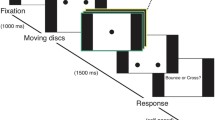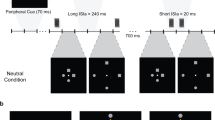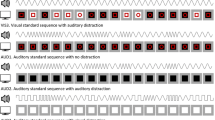Abstract
When looking at two identical objects moving toward each other on a two-dimensional visual display, two different events can be perceived: the objects can either be seen to bounce off each other, or else to stream through one another. Previous research has shown that the large bias normally seen toward the streaming percept can be modulated by the presentation of an auditory event at the moment of coincidence. However, previous behavioral research on this crossmodal effect has always relied on subjective report. In the present experiment, we used a novel experimental design to provide a more objective/implicit measure of the effect of an auditory cue on visual motion perception. In our study, two disks moved toward each other, with the point of coincidence hidden behind an occluder. When emerging from behind the occluder, the disks (one red, the other blue) could either follow the same trajectory (streaming) or else move in the opposite direction (bouncing). Participants made speeded discrimination responses regarding the side from which one of the disks emerged from behind the occluder. Participants responded more rapidly on streaming trials when no sound was presented and on bouncing trials when the sound was presented at the moment of coincidence. These results provide the first empirical demonstration of the auditory modulation of an ambiguous visual motion display using an implicit/objective behavioral measure of perception.


Similar content being viewed by others
Notes
We subsequently conducted a follow-up experiment with an additional nine participants in which only a single predictable trajectory of motion (TB) was used (rather than the three possible paths of motion included in the main experiment). Once again, a significant interaction was found between the Path of motion and Presence of the Sound factors [ F (1,8)=8.0, p <.05]. Participants responded 20 ms faster on sound-absent trials when the target disks reappeared on the opposite side of the occluder (streaming condition, M=323 ms) than when they reappeared on the same side (bounce condition, M=343 ms; p <.01; t- test pairwise comparison). However, in contrast to the results reported in the main text, there was no significant difference in performance between the streaming and bouncing conditions on sound-present trials (M=321 vs. 320 ms, respectively). This latter result may have been caused by the strong ‘dominance’ of the streaming percept over the bouncing percept that is typically found when only one trajectory of motion is presented (e.g. Bertenthal et al. 1993). Therefore, it appears that in order to obtain the specific crossover interaction (i.e. faster RT in the bouncing trials when the sound is present vs. faster RT in the streaming trials when the sound is absent), a paradigm in which different possible trajectories of motion are interleaved may be more appropriate.
References
Bertelson P, de Gelder B (2004) The psychology of multimodal perception. In: C Spence, J Driver (eds) Crossmodal space and crossmodal attention. Oxford University Press, Oxford, pp 141–177
Bertenthal B, Banton T, Bradbury A (1993) Directional bias in the perception of translating patterns. Perception 22:193–207
Bushara KO, Hanakawa T, Immisch I, Toma K, Kansaku K, Hallett M (2002) Neural correlates of cross-modal binding. Nat Neurosci 6:190–195
Calvert G, Spence C, Stein BE (eds) (2004) The handbook of multisensory processes. MIT Press, Cambridge, MA
Driver J, Spence C (2000) Multisensory perception: beyond modularity and convergence. Curr Biol 10:731–735
Michotte A (1963) The perception of causality. In: Miles T, Miles E (trans) Basic Books, New York (Original work published 1946)
Orne MT (1962) On the social psychology of the psychological experiment: with particular reference to demand characteristics and their implications. Am Psychol 17:776–783
Pashler HE (1998) The psychology of attention. MIT Press, Cambridge, MA
Rosenthal R (1967) Covert communication in the psychological experiment. Psychol Bull 67:356–367
Scheier C, Lewkowicz DJ, Shimojo S (2003) Sound induces perceptual reorganization of an ambiguous motion display in human infants. Developmental Science 6:233–244
Schneider W (1988) Micro experimental laboratory: an integrated system for IBM PC compatibles. Behaviour Research Methods, Instruments & Computers 20:206–271
Scholl B, Nakayama K (2002) Causal capture: contextual effects on the perception of collision events. Psychol Sci 13:493–498
Sekuler AB, Sekuler R (1999) Collisions between moving visual targets: What controls alternative ways of seeing an ambiguous display? Perception 28:415–432
Sekuler R, Sekuler AB, Lau R (1997) Sound alters visual motion perception. Nature 385:308
Spence C, Driver J (1997) Audiovisual links in exogenous covert spatial orienting. Percept Psychophys 59:1–22
Vroomen J, de Gelder B (2000) Sound enhances visual perception: Cross-modal effects of auditory organization on vision. J Exp Psychol Hum Percept Perform 26:1583–1590
Watanabe K, Shimojo S (1998) Attentional modulation in perception of visual motion events. Perception 27:1041–1054
Watanabe K, Shimojo S (2001a) Postcoincidence trajectory duration affects motion event perception. Percept Psychophys 63:16–28
Watanabe K, Shimojo S (2001b) When sound affects vision: effects of auditory grouping on visual motion perception. Psychol Sci 12:109–116
Wohlschläger A (2000) Visual motion priming by invisible actions. Vis Res 40:925–930
Author information
Authors and Affiliations
Corresponding author
Rights and permissions
About this article
Cite this article
Sanabria, D., Correa, Á., Lupiáñez, J. et al. Bouncing or streaming? Exploring the influence of auditory cues on the interpretation of ambiguous visual motion. Exp Brain Res 157, 537–541 (2004). https://doi.org/10.1007/s00221-004-1993-z
Received:
Accepted:
Published:
Issue Date:
DOI: https://doi.org/10.1007/s00221-004-1993-z




